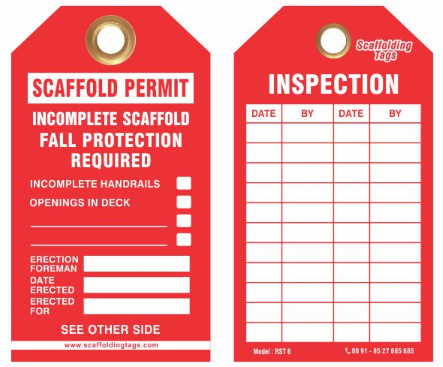
Fall Protection Systems – Most Cited, High Risk
Again this year, Fall Protection is #1 in the most frequently cited standards. Combine this fact that 17% of all work related fatalities are related to falls, slips and trips (second only to transportation incidents at 40%) and you can see the importance of ensuring a complete fall protection system is in place to protect our employees. A complete fall protection system can look a number of different ways, including: guardrail systems, safety net systems, and personal fall arrest systems. Scaffolding, when built and used correctly, are considered a guardrail system when completely erected and all safety measures are in place.
Scaffolding & Personal Fall Arrest Systems
Often in industry and construction, employers require the use of a personal fall arrest system (PFAS), more commonly thought of as a harness and lanyard, in two situations when working from scaffolding: 1) because they have a site-wide policy requiring it to be used 100% of the time, or 2) because the scaffolding is incomplete and is missing an element to would classify it as a guardrail system (e.g. top rail missing, one side missing, no swing gate, etc.), resulting in the need to use a combination of approaches (i.e. partial scaffolding & PFAS).
ABCD of Personal Fall Arrest Systems
Recall A, B, C, D’s for a personal fall arrest system PFAS.
- Anchor (rated at least 5,000 pounds per employee or certified and engineer to have a safety factor of two times the applied load).
- Body Support (full body harness to distribute the load over the entire body).
- Connecting Devices (think self retracting lifelines or shock absorbing lanyards).
- Descent / Rescue (what are the tools and training to ensure a safe descent?).
Can Scaffolding be Used as an Anchor Point?
So if we have an employee working from incomplete scaffolding, and we need to ensure a complete fall arrest system, one of the most difficult considerations often focuses around the anchor point. With the most common question being,
Can scaffolding be used as a suitable anchor point? or, Can I tie off to scaffolding with my lanyard?
OSHA addresses this question in a number of letters of interpretation (LoI) for 29 CFR 1926.502 (Fall Protection Systems Criteria and Practices). Below are a few excerpts from some of their LoI.
Does the OSHA Standards Prohibit Tying Off to a Scaffold?
04/11/2005 Q. Do the OSHA standards prohibit tying off to a scaffold?
A. No… It is OSHA’s position that scaffolding can function as a suitable anchorage for fall arrest systems when the scaffolding section so used is erected and braced such that the criteria of §1926.502(d)(15) are met. This applies whether the scaffold is partially built (i.e., being erected or disassembled) or completely built.
Keep in mind, the response states that the criteria of 1926.502(d)(15) must be met. Those criteria include:
Anchorages used for attachment of personal fall arrest equipment shall be independent of any anchorage being used to support or suspend platforms and capable of supporting at least 5,000 pounds (22.2 kN) per employee attached, or shall be designed, installed, and used as follows: as part of a complete personal fall arrest system which maintains a safety factor of at least two; and under the supervision of a qualified person.
OSHA 1925.502
Can Scaffolding function as a Anchorage Point for PFAS?
OSHA is again clear in stating that scaffolding can serve as a suitable anchor, IF, certain conditions are met: it meets the requirements of 1926.502(d)(15).
It is OSHA’s position that scaffolding can function as a suitable anchorage for fall arrest systems when the scaffolding section so used is erected and braced such that the criteria of 1926.502(d)(15) are met. This applies whether the scaffold is partially built (i.e., being erected or disassembled) or completely built. The provisions of paragraph 1926.502(d)(15) require the anchorage (i.e., the scaffold) either to be capable of supporting at least 5000 pounds, or to be designed, installed, and used as part of a complete personal fall arrest system which maintains a safety factor of at least two.
You are correct that both safety factors — the two to one for the personal fall arrest system and the four to one for the scaffold components — must be maintained. However, the 4 to 1 factor for a component required by section 1926.451(a) applies only to the load which is actually applied or transmitted to the component, not to the total load placed on the scaffold.
While the typical erected scaffold may not withstand the forces imposed by an arrested fall, with proper engineering, a scaffold can be designed so that its components are adequately braced or supported to support such loads. A scaffold should never be used as an anchorage point for a fall arrest system unless it has been properly evaluated by a competent person.
emphasis added
In summary, you must have a competent person “sign-off” on the scaffolding prior to using it as anchor.
Do Scaffolding Manufacturers Allow You to Tie-Off to Their Complete System?
According to Mr. Michael D’Alessio, Director of Engineering at Patent Construction Systems, in the 02/14/1996 LoI, he states,
“No scaffold system in existence in the world today is designed to safely support the kinds of loads that would be imposed upon them by fall arresting systems. For this reason, every major United States manufacturer of scaffolding has signed a letter to the users of our equipment warning against such attachment.”
OSHA responds with an understanding of the concern and reiterates the requirements of 1926.502(d)(15), stating,
“With respect to the question of whether or not scaffolds can be used as anchorage points for personal fall arrest systems, please be advised that we understand the Scaffold Industry Association and the Scaffolding, Shoring & Forming Institute are concerned that scaffolds and scaffold components have not been designed to accept the forces imposed by employee falls. We agree that during the erection and dismantling process the typical scaffold is unable to comply with the criteria of 29 CFR 1926.502(d)(15) which requires the anchorage (i.e. the scaffold) to be capable of supporting at least 5000 pounds per employee attached. The alternative anchorage criteria referenced in 29 CFR 1926.502(d)(15)(i) and (ii) (e.g. a system designed, installed and used under the supervision of a qualified person as part of a complete personal fall arrest system which maintains a safety factor of at least two) may be used if the partially erected or completed scaffold is considered a part of the complete personal fall arrest system criteria and is capable of resisting the forces involved should there be a fall.”
TLDR
In summary, OSHA does not prohibit tying off to scaffolding if the requirements of 1926.502.d.15 are met: anchor capable of supporting at least 5,000 pounds per employee attached, used as part of a complete personal fall arrest system which maintains a safety factor of at least two, and under the supervision of a qualified person.
Additional Reading
Also, check out 5 of the most common OSHA responses to scaffolding questions via OHShub’s post on OSHA Interpretations: 5 Responses to Scaffolding.

